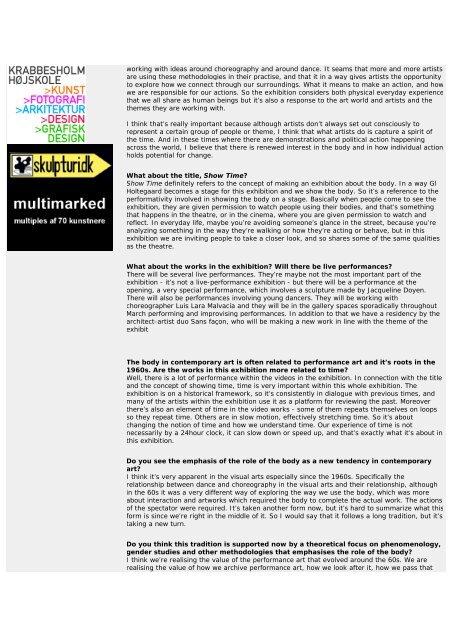Weekendavisen - Liberty Paterson
Weekendavisen - Liberty Paterson
Weekendavisen - Liberty Paterson
Create successful ePaper yourself
Turn your PDF publications into a flip-book with our unique Google optimized e-Paper software.
working with ideas around choreography and around dance. It seams that more and more artists<br />
are using these methodologies in their practise, and that it in a way gives artists the opportunity<br />
to explore how we connect through our surroundings. What it means to make an action, and how<br />
we are responsible for our actions. So the exhibition considers both physical everyday experience<br />
that we all share as human beings but it’s also a response to the art world and artists and the<br />
themes they are working with.<br />
I think that’s really important because although artists don’t always set out consciously to<br />
represent a certain group of people or theme, I think that what artists do is capture a spirit of<br />
the time. And in these times where there are demonstrations and political action happening<br />
across the world, I believe that there is renewed interest in the body and in how individual action<br />
holds potential for change.<br />
What about the title, Show Time?<br />
Show Time definitely refers to the concept of making an exhibition about the body. In a way Gl<br />
Holtegaard becomes a stage for this exhibition and we show the body. So it’s a reference to the<br />
performativity involved in showing the body on a stage. Basically when people come to see the<br />
exhibition, they are given permission to watch people using their bodies, and that’s something<br />
that happens in the theatre, or in the cinema, where you are given permission to watch and<br />
reflect. In everyday life, maybe you’re avoiding someone’s glance in the street, because you’re<br />
analyzing something in the way they’re walking or how they’re acting or behave, but in this<br />
exhibition we are inviting people to take a closer look, and so shares some of the same qualities<br />
as the theatre.<br />
What about the works in the exhibition? Will there be live performances?<br />
There will be several live performances. They’re maybe not the most important part of the<br />
exhibition - it’s not a live-performance exhibition - but there will be a performance at the<br />
opening, a very special performance, which involves a sculpture made by Jacqueline Doyen.<br />
There will also be performances involving young dancers. They will be working with<br />
choreographer Luis Lara Malvacía and they will be in the gallery spaces sporadically throughout<br />
March performing and improvising performances. In addition to that we have a residency by the<br />
architect-artist duo Sans façon, who will be making a new work in line with the theme of the<br />
exhibit<br />
The body in contemporary art is often related to performance art and it’s roots in the<br />
1960s. Are the works in this exhibition more related to time?<br />
Well, there is a lot of performance within the videos in the exhibition. In connection with the title<br />
and the concept of showing time, time is very important within this whole exhibition. The<br />
exhibition is on a historical framework, so it’s consistently in dialogue with previous times, and<br />
many of the artists within the exhibition use it as a platform for reviewing the past. Moreover<br />
there’s also an element of time in the video works - some of them repeats themselves on loops<br />
so they repeat time. Others are in slow motion, effectively stretching time. So it’s about<br />
changing the notion of time and how we understand time. Our experience of time is not<br />
necessarily by a 24hour clock, it can slow down or speed up, and that’s exactly what it’s about in<br />
this exhibition.<br />
Do you see the emphasis of the role of the body as a new tendency in contemporary<br />
art?<br />
I think it’s very apparent in the visual arts especially since the 1960s. Specifically the<br />
relationship between dance and choreography in the visual arts and their relationship, although<br />
in the 60s it was a very different way of exploring the way we use the body, which was more<br />
about interaction and artworks which required the body to complete the actual work. The actions<br />
of the spectator were required. It’s taken another form now, but it’s hard to summarize what this<br />
form is since we’re right in the middle of it. So I would say that it follows a long tradition, but it’s<br />
taking a new turn.<br />
Do you think this tradition is supported now by a theoretical focus on phenomenology,<br />
gender studies and other methodologies that emphasises the role of the body?<br />
I think we’re realising the value of the performance art that evolved around the 60s. We are<br />
realising the value of how we archive performance art, how we look after it, how we pass that


